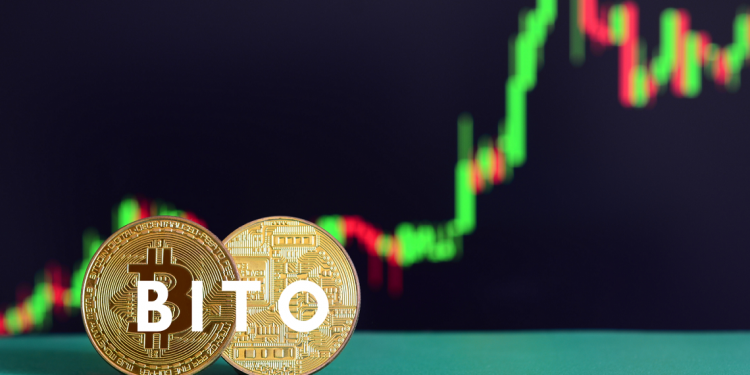The ProShares Bitcoin Strategy Exchange Traded Fund is the inaugural bitcoin-oriented ETF in the United States, providing investors with a straightforward, fluid, and accessible way to acquire experience when it comes to bitcoin earnings. It received the approval of the U.S Securities and Exchange Commission on Friday. The Fund’s primary goal is to generate wealth growth by managing risk associated with bitcoin futures contracts. Let’s get you all the details regarding BITO ETF Price Prediction.
BITO ETF Price Prediction
Bitcoin ETF began trading, with the ticker symbol ‘BITO’, on the New York Stock Exchange on Tuesday, marking a watershed milestone in the history of the cryptocurrency marketplace. This novel ETF will provide a channel to bitcoin to those clients with a trading account who may normally be hesitant to enter the uncontrolled territory. Instead of immediately engaging in bitcoin, the ProShares ETF is designed to participate in bitcoin futures contracts listed on the Chicago Mercantile Exchange (CME).
As a result, the ETF by itself will not stimulate fresh demand for bitcoin. Traders, on the other hand, may purchase more bitcoin in order to safeguard against futures price volatility or leverage pricing discrepancies to their benefit. It has to be comprehended that bitcoin futures prices and behavior are likely to deviate from the prevailing price at which the bitcoin can be purchased. Let’s get you more details on BITO ETF Price Prediction.
How is BITO Distinct from Purchasing Bitcoin
Acquiring Bitcoin directly has its own array of costs, which vary based on which platform the user employs, how payment is made for the user’s account, and other variables. BITO has its own set of fees. BITO and other specialized ETFs have a higher cost ratio, which implies they are more costly for individuals. The expense ratio for BITO is 0.95 percent, which specialists consider to be extremely high. In other words, the fund’s running expenditures will consume $95 of every $10,000 contributed. The finest inexpensive funds, according to professionals, have expense ratios lower than 0.3 percent. Trades can be placed during non-market hours, but they will not be executed until the stock market resumes. An individual will not be able to utilize BITO to make purchasing decisions during the weekends or evenings as one can with Bitcoins.

BITO ETF Price Prediction Overview
The current price of the BITO ETF is $42.04, indicating an increase of 4.85% from its debut-day close. At the closing of the stock marketplace on Tuesday, the value of the exchange-traded fund stood at $41.94, representing an increase of 4.9% from its starting net asset value of $40. On its debut day, the fund witnessed roughly $1 billion in transaction traffic, making it the second highly exchanged new ETF in history.
ProShares Bitcoin ETF is on the verge of breaching the futures contract ceiling
The rapid entrance of this futures-oriented bitcoin ETF places it in danger of exceeding the Chicago Mercantile Exchange’s (CME) threshold for the volume of bitcoin futures agreements it is permitted to possess. Bito ETF is precisely only 1,700 contracts distant from the maximum limit prescribed by CME. This follows as Bito ETF surpassed the $1.1 billion milestones in assets-under-management in a period of only 2 days, shattering the 18-year-old benchmark established by the SPDR Gold Trust ETF for the speediest ETF to attain that level. Bito ETF transacted around 1,900 contracts in the month of October by the conclusion of its second day, approaching the 2,000 contracts ceiling specified by CME for this month.
Pursuant to information collected by Bloomberg Intelligence, Bito ETF reported 1,400 contracts active for November by the close of business on Thursday, compared to the CME’s aggregate upper restriction of 5,000 active agreements for months taken into consideration altogether. Bito ETF has currently utilized about two-thirds of its overall capacity, implying that only $600 million in additional assets are essential to reach the maximum ceiling. ProShares increased its creation charge from one percentage unit to ten on Thursday, causing cash inflows into Bito ETF to decelerate to $100 million. Meanwhile, the debut of Valkyrie’s bitcoin-based ETF instrument on Friday compelled ProShares to revert to the initial charge range.
BITO ETF Price Prediction Future And Prospects
The outlook for Bito ETF is moderate. Some analysts are of the opinion that BITO will be successful in delivering higher cash inflows as compared to the inflows attracted by ‘Invesco QQQ Trust Series 1 Fund’ in the year 2002. In addition, they anticipate that this ETF will allow a much larger number of people to invest in cryptocurrency and generate over $50 billion worth of inflows in the first year.
A futures-linked Bitcoin ETF has skeptics among registered investment advisors (RIAs). Investors are also apprehensive about the intricacy of a futures-oriented product versus spot crypto trading. While economic actors’ views on the nascent ETF’s prospects may differ, many concur that it represents a significant legislative victory for the cryptocurrency community. The exchange-traded fund is expected to open up new opportunities in this market.
Concluding Remarks
Bitcoin is still a relatively new investment when compared to traditional investment avenues, thus it lacks the chronicled track record that investors may deploy to predict future success. Before investing in a Bitcoin ETF, one should always keep in mind to invest what one can afford to lose, and never at the price of other financial objectives like debt repayment or accumulating savings for leading a smooth lifestyle post-retirement. Bitcoin is incredibly unstable, and while there may be a price differential between Bitcoin and BITO, the ETF does not offer protection from highs and lows.
Bitcoin reached an all-time high of approximately $60,000 in April this year, before dramatically shedding 50% of its value during the summer, but it has now rebounded to somewhere around $60,000. A similar range of unpredictability can be expected in Bitcoin ETF, owing to which analysts suggest investing no more than 5% of the overall portfolio in such ETFs.
Stay Connected with Global Coverage For Further details.

